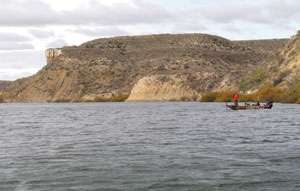
DEL RIO, Texas — The recent passing of Hurricane Alex across central Mexico included massive rain bands that dumped a deluge of water into the feeder creeks and canyons supplying Lake Amistad, one of the hottest bass lakes in North America.
So much water rushed into the nearly 65,000-acre border impoundment that it quickly swelled to 14 feet above conservation pool in less than a week, forcing the International Boundary and Water Commission (IBWC) to begin releasing water into the Rio Grande in hopes of getting Amistad back to normal pool.
The water release is the largest since 1974, and it caused the evacuation of a downstream neighborhood in Val Verde County that was within the floodplain, according to Sally Spener, spokesperson for the IBWC.
Spener indicated this effort would take some time. "The lake is slowly coming back down," she said, "and since the hurricane season is still upon us, we want to be prudent and not leave the lake above conservation pool in the chance we get another heavy rain event across the watershed." She also noted the current release out of Amistad is the largest volume of water released from the reservoir since 1974, causing the evacuation of one downstream neighborhood in Val Verde County located within the floodplain.
All that water has only one place to go — Lake Falcon, a superhot bass lake located downstream on the Rio Grande — which sorely needs it. Spener explained that while Amistad was at full pool prior to the hurricane, Falcon was only at 62 percent capacity. The subsequent rise on Falcon was approaching record storage level for that impoundment at the time this was written.
Keith Combs, a Bassmaster Central Open competitor and frequent guide on both Falcon and Amistad, said he welcomes the rising water on Lake Falcon.
"With the recent rise on Amistad in July, the bass immediately went into the shallow bushes with the high water, and that's exactly what we expect with the fish on Falcon," he said. "The flooded bushes are a magnet for thousands of sunfish picking off stranded insects among the shallows, which in turn draws the bass to the same areas to feed."
According to Spener, the IBWC plans to return both reservoirs back to their normal pool levels as soon as it is deemed advisable.
Even then, Combs said he believes the shallow bite in both reservoirs could remain strong. "The last time the water came up quickly on Falcon, those fish continued to stay shallow for some time, even when the water began to recede."
Finally, after the much publicized incidents of armed Mexican pirates seeking out U.S. citizens on the Mexican side of Lake Falcon earlier this year, a U.S. Border Patrol officer indicated there have been no subsequent incidents to report on the lake, likely because of an increased presence of U.S. authorities patrolling the American side of the border impoundment.
No threats have been reported on Lake Amistad; however, the agent recommended keeping alert of one's surroundings when fishing the Mexican waters of both reservoirs.
For guided fishing trips on Lake Amistad or Falcon, visitors to south Texas can contact Keith Combs at 254-681-9566. Up-to-date conditions on the water levels at both lakes can be checked at the International Boundary and Water Commissions website, www.ibwc.state.gov, or by phone at 830-775-2437.
